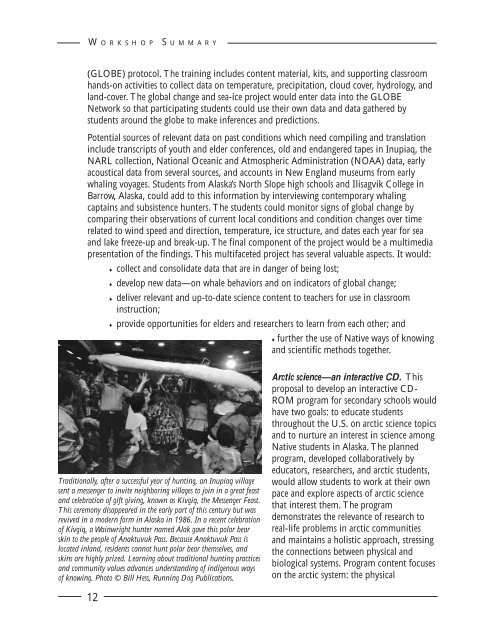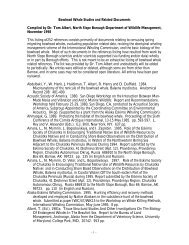ed report 4 page cover - Arctic Research Consortium of the United ...
ed report 4 page cover - Arctic Research Consortium of the United ...
ed report 4 page cover - Arctic Research Consortium of the United ...
You also want an ePaper? Increase the reach of your titles
YUMPU automatically turns print PDFs into web optimized ePapers that Google loves.
W O R K S H O P S U M M A R Y<br />
(GLOBE) protocol. The training includes content material, kits, and supporting classroom<br />
hands-on activities to collect data on temperature, precipitation, cloud <strong>cover</strong>, hydrology, and<br />
land-<strong>cover</strong>. The global change and sea-ice project would enter data into <strong>the</strong> GLOBE<br />
Network so that participating students could use <strong>the</strong>ir own data and data ga<strong>the</strong>r<strong>ed</strong> by<br />
students around <strong>the</strong> globe to make inferences and pr<strong>ed</strong>ictions.<br />
Potential sources <strong>of</strong> relevant data on past conditions which ne<strong>ed</strong> compiling and translation<br />
include transcripts <strong>of</strong> youth and elder conferences, old and endanger<strong>ed</strong> tapes in Inupiaq, <strong>the</strong><br />
NARL collection, National Oceanic and Atmospheric Administration (NOAA) data, early<br />
acoustical data from several sources, and accounts in New England museums from early<br />
whaling voyages. Students from Alaska’s North Slope high schools and Ilisagvik College in<br />
Barrow, Alaska, could add to this information by interviewing contemporary whaling<br />
captains and subsistence hunters. The students could monitor signs <strong>of</strong> global change by<br />
comparing <strong>the</strong>ir observations <strong>of</strong> current local conditions and condition changes over time<br />
relat<strong>ed</strong> to wind spe<strong>ed</strong> and direction, temperature, ice structure, and dates each year for sea<br />
and lake freeze-up and break-up. The final component <strong>of</strong> <strong>the</strong> project would be a multim<strong>ed</strong>ia<br />
presentation <strong>of</strong> <strong>the</strong> findings. This multifacet<strong>ed</strong> project has several valuable aspects. It would:<br />
♦ collect and consolidate data that are in danger <strong>of</strong> being lost;<br />
♦ develop new data—on whale behaviors and on indicators <strong>of</strong> global change;<br />
♦ deliver relevant and up-to-date science content to teachers for use in classroom<br />
instruction;<br />
♦ provide opportunities for elders and researchers to learn from each o<strong>the</strong>r; and<br />
♦ fur<strong>the</strong>r <strong>the</strong> use <strong>of</strong> Native ways <strong>of</strong> knowing<br />
and scientific methods toge<strong>the</strong>r.<br />
Traditionally, after a successful year <strong>of</strong> hunting, an Inupiaq village<br />
sent a messenger to invite neighboring villages to join in a great feast<br />
and celebration <strong>of</strong> gift giving, known as Kivgiq, <strong>the</strong> Messenger Feast.<br />
This ceremony disappear<strong>ed</strong> in <strong>the</strong> early part <strong>of</strong> this century but was<br />
reviv<strong>ed</strong> in a modern form in Alaska in 1986. In a recent celebration<br />
<strong>of</strong> Kivgiq, a Wainwright hunter nam<strong>ed</strong> Alak gave this polar bear<br />
skin to <strong>the</strong> people <strong>of</strong> Anaktuvuk Pass. Because Anaktuvuk Pass is<br />
locat<strong>ed</strong> inland, residents cannot hunt polar bear <strong>the</strong>mselves, and<br />
skins are highly priz<strong>ed</strong>. Learning about traditional hunting practices<br />
and community values advances understanding <strong>of</strong> indigenous ways<br />
<strong>of</strong> knowing. Photo © Bill Hess, Running Dog Publications.<br />
12<br />
<strong>Arctic</strong> science—an interactive CD. This<br />
proposal to develop an interactive CD-<br />
ROM program for secondary schools would<br />
have two goals: to <strong>ed</strong>ucate students<br />
throughout <strong>the</strong> U.S. on arctic science topics<br />
and to nurture an interest in science among<br />
Native students in Alaska. The plann<strong>ed</strong><br />
program, develop<strong>ed</strong> collaboratively by<br />
<strong>ed</strong>ucators, researchers, and arctic students,<br />
would allow students to work at <strong>the</strong>ir own<br />
pace and explore aspects <strong>of</strong> arctic science<br />
that interest <strong>the</strong>m. The program<br />
demonstrates <strong>the</strong> relevance <strong>of</strong> research to<br />
real-life problems in arctic communities<br />
and maintains a holistic approach, stressing<br />
<strong>the</strong> connections between physical and<br />
biological systems. Program content focuses<br />
on <strong>the</strong> arctic system: <strong>the</strong> physical




